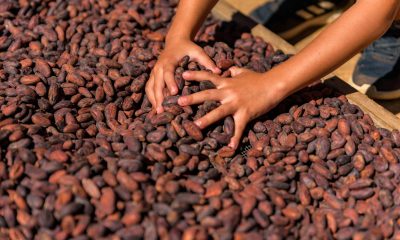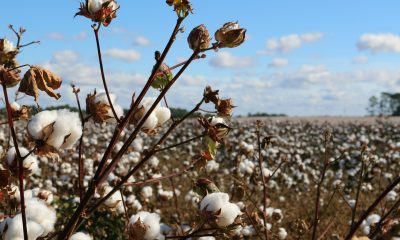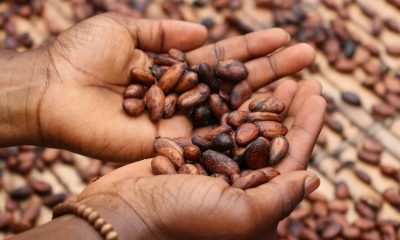Markets
Why Coffee Prices Increased Last Week
Coffee prices in New York and London rose last week due to short supply concerns, reduced Robusta offers, and smaller crops in Vietnam and Brazil. Markets are volatile, with bigger rally days than losses. Despite recent rain in Vietnam, earlier damage and poor Robusta yields in Brazil contribute to supply issues.

Wheat: Wheat was lower in all three markets last week with selling seen again on Friday due to increased Winter Wheat production estimates from USDA. The production data helped push ending stocks estimates above trade expectations. US harvest progress and ideas of good yields and crops went against reports of hot and dry weather in eastern Europe and Russia and too wet weather in France are still heard and the weather there affecting world production estimates.
Russia is likely to expand the war and has reportedly started to make some threats against the US and NATO countries. The US harvest is expanding through Kansas and is now more than 50% complete for the country as a whole and adverse world growing conditions are still around. There were more reports of hot temperatures coming this week to Russian growing areas. It has also been very dry there. Eastern Europe is also hot and dry. Western Europe has seen too much rain.
Weekly Chicago Soft Red Winter Wheat Futures
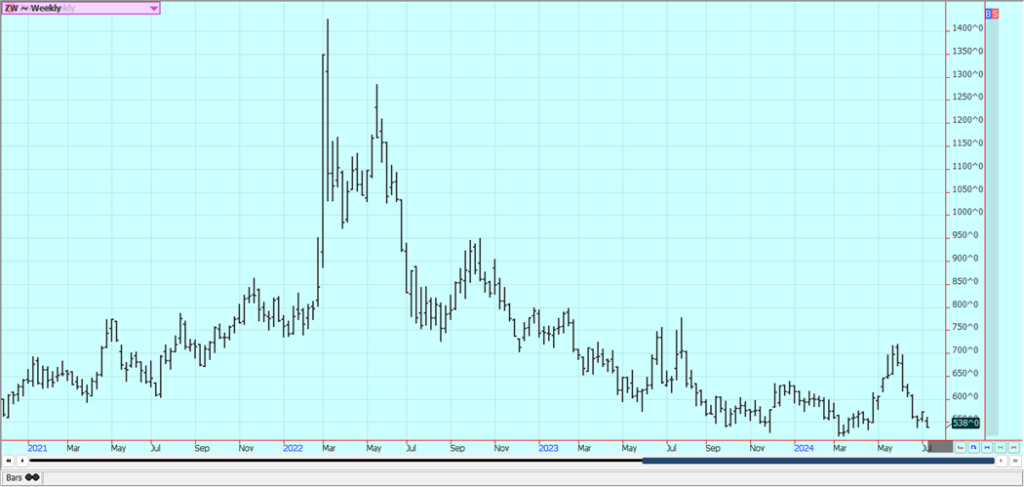
Weekly Chicago Hard Red Winter Wheat Futures
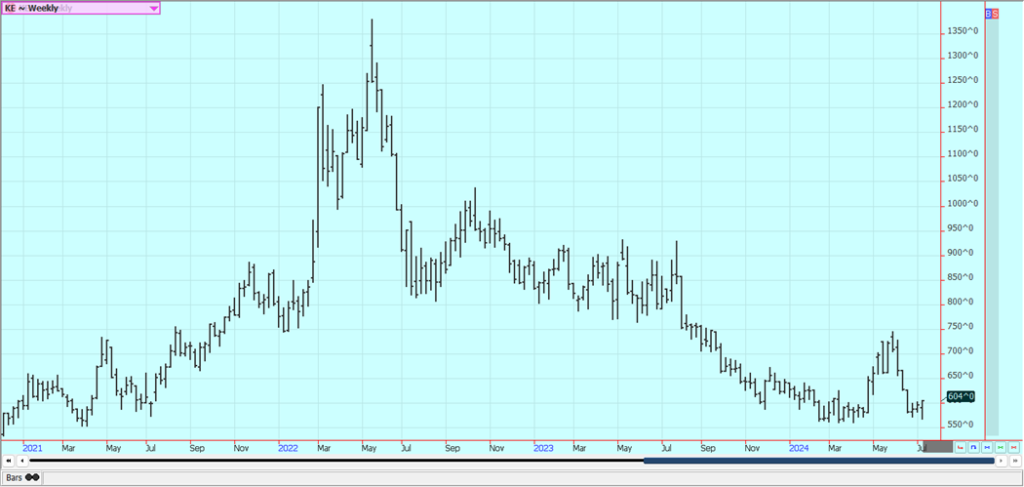
Weekly Minneapolis Hard Red Spring Wheat Futures
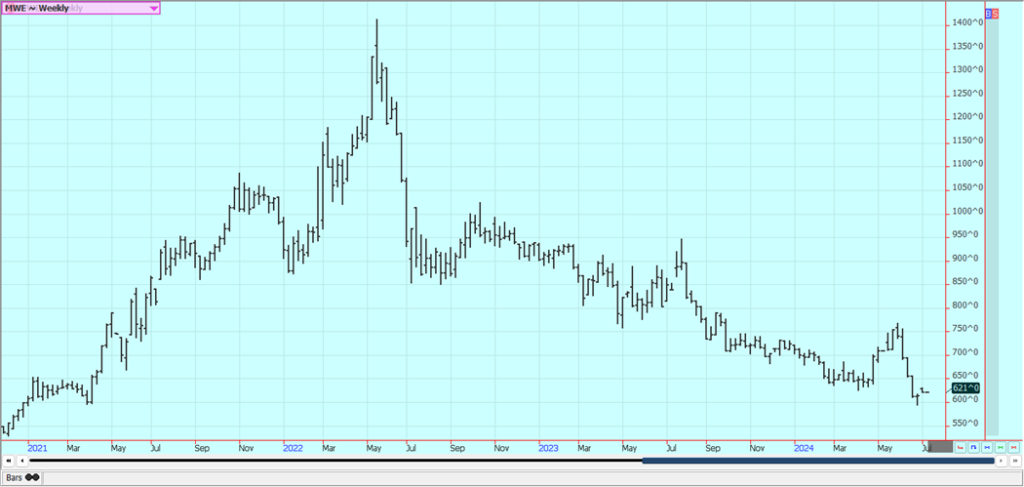
Corn: Corn closed lower last week and Oats closed higher. The WASDE reports featured no real surprises as Corn production was increased due to increased planted area. Demand was higher, so ending stocks were slightly less than last month. Hurricane Beryl brought beneficial precipitation to the southern and eastern Midwest.
Current forecasts call for hotter and drier weather for the Midwest this week. Weakness was based on hopes for improved crop condition ratings to be released on Monday afternoon. The US weather features moderate temperatures and increasing chances for rains. Northern areas such as southern Minnesota that have had way too much rain and flooding is still reported.
Weekly Corn Futures
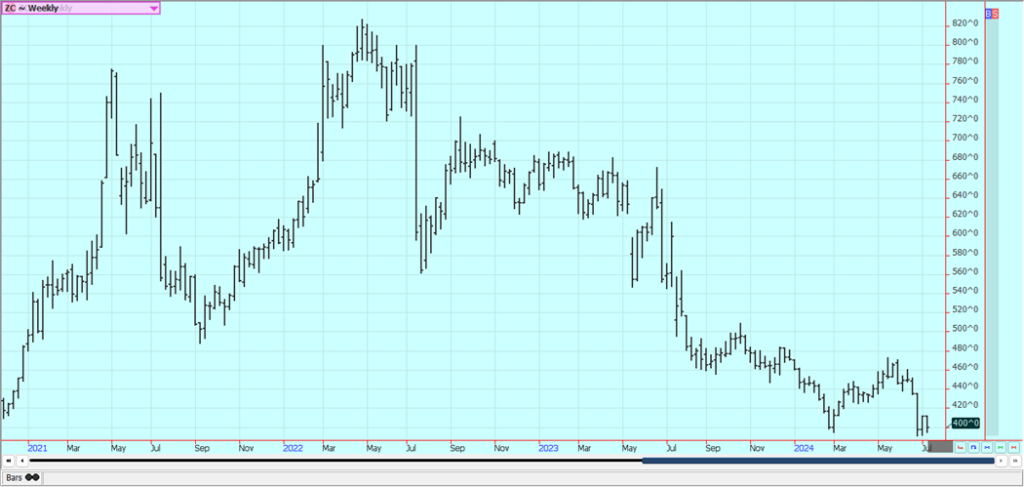
Weekly Oats Futures

Soybeans and Soybean Meal: Soybeans and the products closed lower last week as the weathr improved. Hurricane Beryl brought beneficial precipitation to areas of the southern and eastern Midwest where conditions have been too dry until now. Northern and western areas should turn drier which is also beneficial for crops. USDA issued its latest WASDE estimates on Friday and Soybeans could not hold a rally attempt even with the data showing less than expected ending stocks due primarily to increased domestic use.
Production was in line with projections as USDA used the new acreage estimates released at the end of June and trend line yield estimates as expected. Reports indicate that China remains an active buyer of Soybeans in Brazil but has cut back and increased purchases from the US on demand due to the tax issues in Brazil and on Brazil logistical concerns. Domestic demand has been strong in the US but has suffered as crushers were crushing for oil. Oil demand has suffered as cheaper alternatives for feedstocks hit the biofuels market.
Weekly Chicago Soybeans Futures

Weekly Chicago Soybean Meal Futures
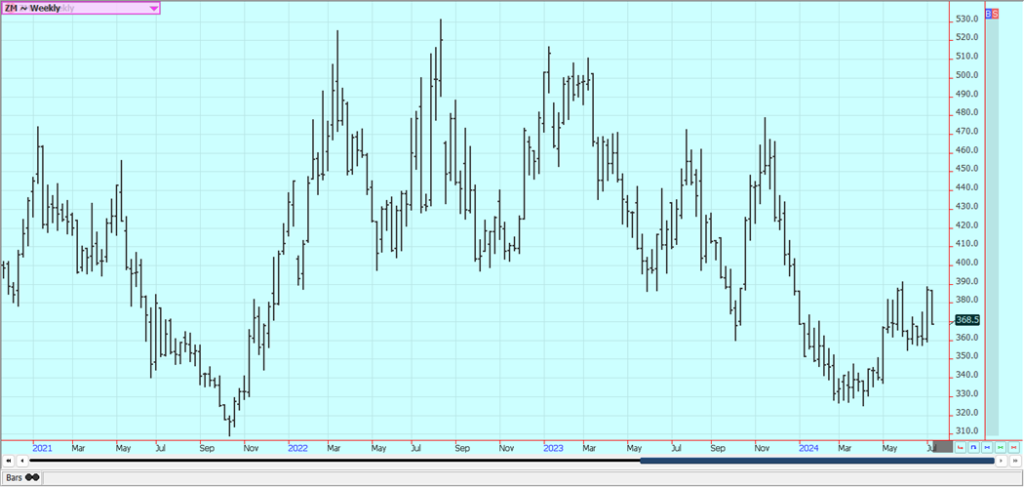
Rice: Rice closed sharply higher in July, but a little lower in the new crop months as the market thinks there will be no supply problem next year dye to better growing conditions and increased planted area. Hurricane Beryl has passed by but hit growing areas with the damaging parts of the storm in and around the Houston area.
The system has brought beneficial rains to Arkansas and other parts of the Delta. The US weather has been an issue much of the growing season with too much rain early in the year and now a hurricane that dropped big amounts of rain on cops again along with some high winds. Inland Texas areas could also see too much rain. Supply tightness is expected to give way to increased production this year and greatly increased supplies this Fall.
Weekly Chicago Rice Futures
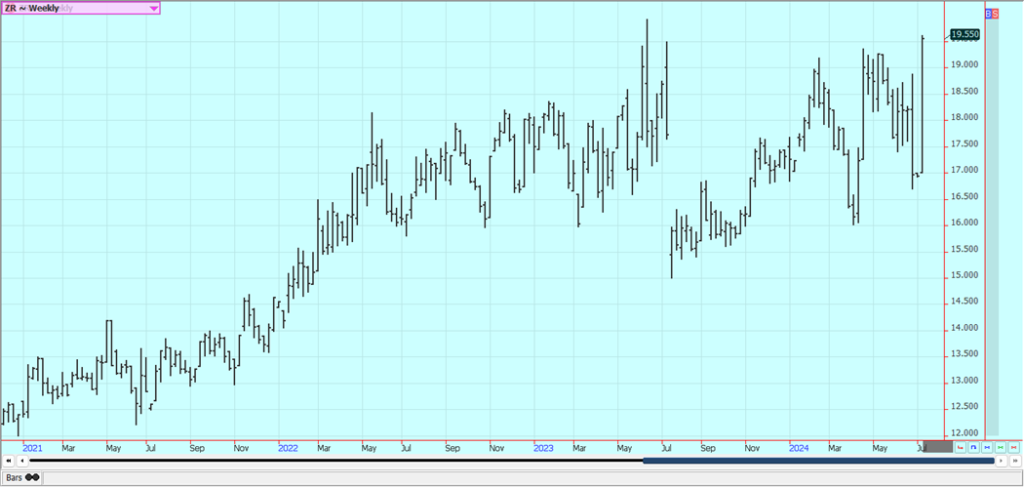
Palm Oil and Vegetable Oils: Palm Oil was lower last week on ideas oof increasing supplies. Reports indicate that production is rising as well. Export demand has been very strong in recent private reports but has been weaker in recent days. There is talk of increased supplies available to the market, and the trends are down on the daily charts. Canola was lower last week as oilseed supplies look to be ample in the coming year.
The daily charts show that Canola trends are down.
Palm Oil was lower last week on ideas oof increasing supplies. Reports indicate that production is rising as well. Export demand has been very strong in recent private reports but has been weaker in recent days. There is talk of increased supplies available to the market, and the trends are down on the daily charts. Canola was lower last week as oilseed supplies look to be ample in the coming year. The daily charts show that Canola trends are down.
Weekly Malaysian Palm Oil Futures:
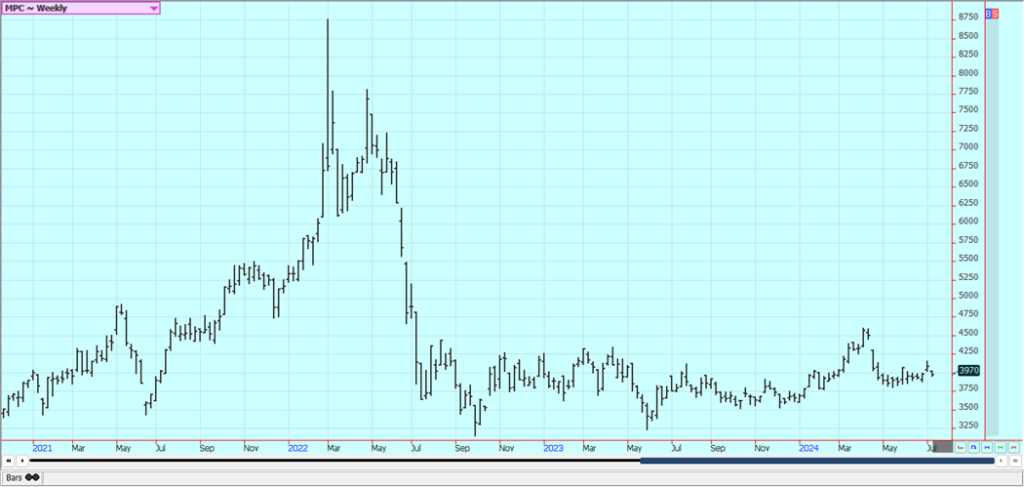
Weekly Chicago Soybean Oil Futures
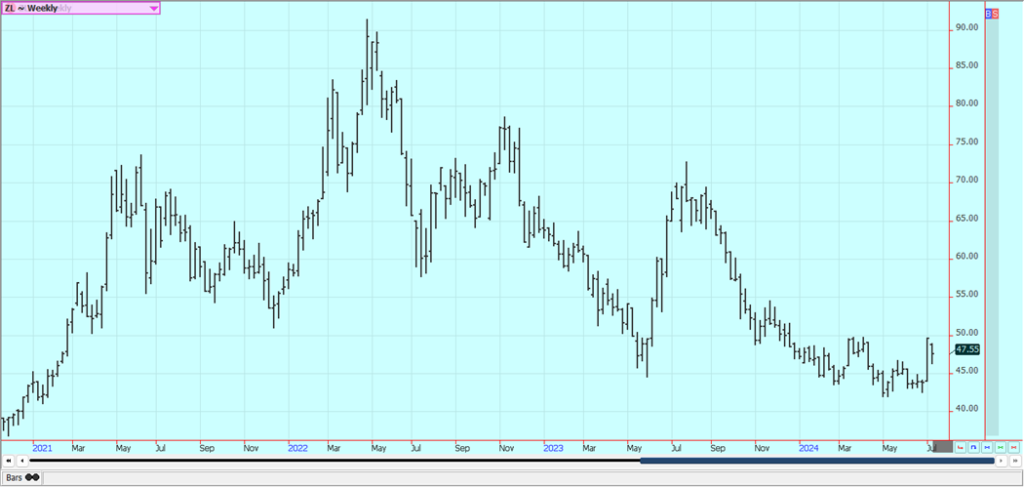
Weekly Canola Futures
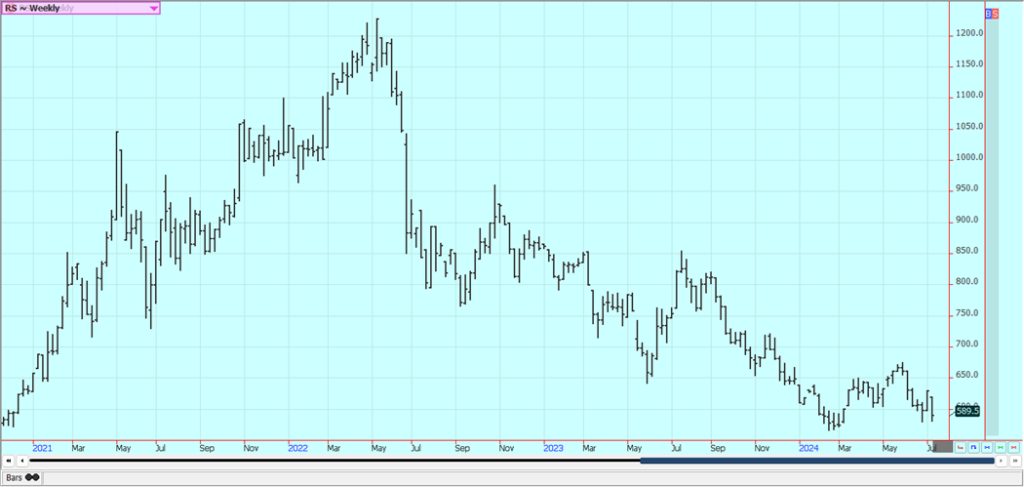
Cotton: Cotton was a little higher last week in range trading as Hurricane Beryl is part of the past and as the USDA WASDE reports released on Friday produced no bearish surprises. USDA increased production estimates by one million bales and left the demand side untouched for an increase in US ending stocks levels. World ending stocks levels were reduced slightly as world growing conditions are more suspect.
The demand as reflected in the weekly USDA export sales report was poor. USDA showed a decrease in production conditions for the crops in its reports last week that were the result of some extreme weather seen recently in Texas and the Southeast. The Delta should have the best looking crops right now. Demand has been weaker so far this year but there are hopes for improved demand with the lower prices. Chinese consumer demand has held together well, and Chinese demand for Cotton has started to increase.
Weekly US Cotton Futures

Frozen Concentrated Orange Juice and Citrus: FCOJ closed a little higher last week as the hurricane watch continued. Traders also reacted to the USDA production reports released on Friday tat showed slight increases in production in Florida and California. Hurricane Beryl missed Florida and there are no other storms in sight for the state for now, but a very active year is forecast and there have been some reports of flooding in the state even with no huge storms.
The market remains well supported in the longer term based on forecasts for tight supplies and very hot weather in Florida. The reduced production appears to be at the expense of the greening disease. There are no weather concerns to speak of for Florida or for Brazil right now. The weather has improved in Brazil with some moderation in temperatures and increased rainfall amid reports of short supplies in Florida and Brazil are around but will start to disappear as the weather improves and the new crop gets harvested.
Weekly FCOJ Futures
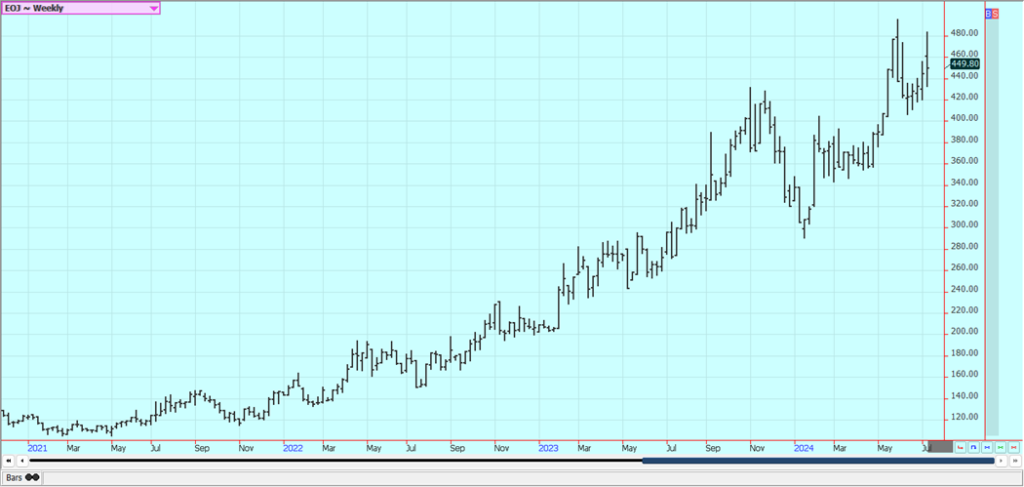
Coffee: New York and London closed higher last week on more reports of short coffee supplies that could be made worse by ideas of reduced offers of Robusta are still in the market. Coffee offers from Vietnam are reported to be down significantly and the current coffee crop in Brazil along with the next crop in Vietnam s reported to be smaller.
These coffee markets are up sharply one day and down sharply the next, but the rally days are bigger than the loss days. The weather forecasters now say that conditions are good in Vietnam, but damage was done to coffee crops earlier in the growing season. A little rain has been reported in Vietnam recently to help coffee crops there. There were also reports of poor Robusta yields in Brazil during the harvest due to small bean sizes.
Weekly New York Arabica Coffee Futures

Weekly London Robusta Coffee Futures

Sugar: New York and London closed lower last week as harvest progress in Brazil was the important fundamental but as world supplies remain rather tight. Harvest yields of Sugarcane in Brazil are improv-ing, and UNICA said that Sugar production was up more than 20% from last year at 3.25 million tons. The market had expected this increase. There are still ideas that the Brazil harvest can be strong for the next few weeks amid dry harvest weather. Harvest weather is called good in center-south Brazil.
Weekly New York World Raw Sugar Futures

Weekly London White Sugar Futures

Cocoa: New York closed higher and London closed little changed last week. The European Cocoa grind was 357,502 tons, up 4.1% from last year. The data was supportive to prices. Production concerns in West Africa as well as demand from nontraditional sources along with traditional buyers keep supporting futures, but this support is running its course and the market is searching for a new bullish fundamental. Production in West Africa could be reduced this year due to the extreme weather which included Har-mattan conditions. The availability of Cocoa from West Africa remains very restricted.
Weekly New York Cocoa Futures

Weekly London Cocoa Futures
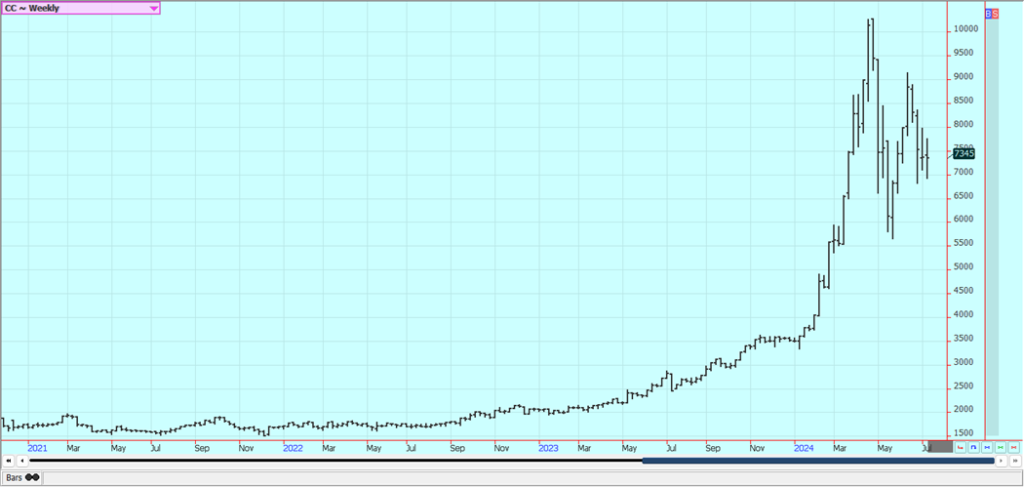
__
(Featured image by Couleur via Pixabay)
DISCLAIMER: This article was written by a third party contributor and does not reflect the opinion of Born2Invest, its management, staff or its associates. Please review our disclaimer for more information.
This article may include forward-looking statements. These forward-looking statements generally are identified by the words “believe,” “project,” “estimate,” “become,” “plan,” “will,” and similar expressions. These forward-looking statements involve known and unknown risks as well as uncertainties, including those discussed in the following cautionary statements and elsewhere in this article and on this site. Although the Company may believe that its expectations are based on reasonable assumptions, the actual results that the Company may achieve may differ materially from any forward-looking statements, which reflect the opinions of the management of the Company only as of the date hereof. Additionally, please make sure to read these important disclosures.
Futures and options trading involves substantial risk of loss and may not be suitable for everyone. The valuation of futures and options may fluctuate and as a result, clients may lose more than their original investment. In no event should the content of this website be construed as an express or implied promise, guarantee, or implication by or from The PRICE Futures Group, Inc. that you will profit or that losses can or will be limited whatsoever.
Past performance is not indicative of future results. Information provided on this report is intended solely for informative purpose and is obtained from sources believed to be reliable. No guarantee of any kind is implied or possible where projections of future conditions are attempted. The leverage created by trading on margin can work against you as well as for you, and losses can exceed your entire investment. Before opening an account and trading, you should seek advice from your advisors as appropriate to ensure that you understand the risks and can withstand the losses.

-

 Africa7 days ago
Africa7 days agoDamane Cash and FMSCD Partner to Enable Cash Advance in Exchange Offices
-

 Crowdfunding2 days ago
Crowdfunding2 days agoGörlitz Christmas Crowdfunding Campaign Exceeds All Goals
-

 Business2 weeks ago
Business2 weeks agoThe TopRanked.io Weekly Digest: What’s Hot in Affiliate Marketing [Super Partners Review]
-

 Business6 days ago
Business6 days agoThe TopRanked.io Weekly Digest: What’s Hot in Affiliate Marketing [BullionVault Affiliates Review]
